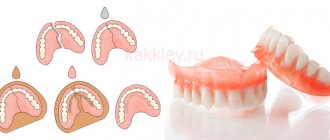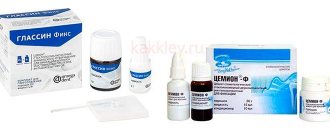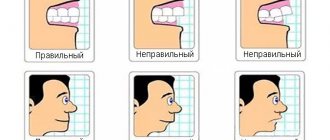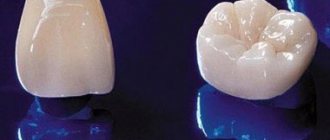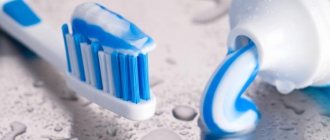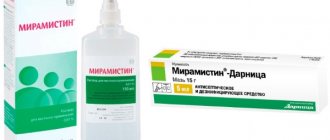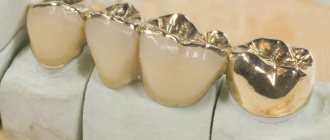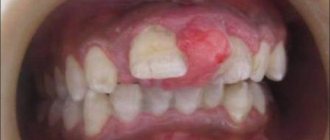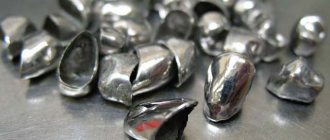Why did the crown fall off?
There are many reasons that can provoke an unpleasant situation. According to statistics, the following happens most often:
- The crown fell off because the patient did not comply with operating conditions, such as biting hard food or shelling nuts.
- A mechanical injury occurred, the person fell or hit himself, which led to the crown falling out.
- A medical error was made; before attaching the prosthesis, the tooth was severely ground down, as a result of which it became an unreliable mount for the artificial product.
- The wrong size prosthesis was used, so the crown fell off the tooth.
- Incorrect attachment sequence of the artificial unit, for example, saliva was not sufficiently isolated when applying the adhesive.
We can conclude that the cause of a fallen crown can be not only the patient’s incorrect actions, but also the dentist’s oversight. To avoid this, we advise you to contact only trusted medical centers and highly qualified specialists.
What can be done if loss has already occurred?
If a crown falls off, it is not always possible to contact a dentist immediately. This could be an episode of emergency at work, or a business trip. Or the option is that “your”, “favorite”, etc. dentist is on vacation right now.
Considering that complete installation of the crown in place at home is technically impossible, measures should be taken to temporarily strengthen it. To regain the temporary ability to at least chew (we are not talking about a Hollywood smile here at all).
Carrying out repairs in camping and home conditions is possible with the help of:
- dental cement;
- dental glue.
The option with glue implies a faster repair, while with cement there is greater structural strength, but both of them are a temporary measure, nothing more.
We will give several general recommendations that do not depend on the choice of fixation method.
The removed prosthesis should be carefully examined, identifying its front and back surfaces. Only after this, having thoroughly washed and dried the crown and cleaned the exposed tooth-base, should you carefully and correctly put it on, carefully and slowly clench your teeth. If the adhesion to the base tooth is sufficient (the crown does not rotate or be removed), you can leave the situation unchanged for one or two days.
If the crown does not fit like a glove, you should carefully remember its correct, most comfortable position, guided by your own feelings.
The method of attaching the crown should be chosen based on the goals - glue is a faster, but less durable method of fixation, cement is a more reliable, but at the same time difficult way to achieve what you want.
Types of cracks
Note! The closer to the neck (gum) the damage is located, the greater the likelihood of losing the crown of the tooth. This means the risk of tooth loss increases and it will take much more time and money to restore it.
- horizontal: in this case there is a girdle crack around the crown,
- vertical: located parallel to the direction of growth and divides the tooth into two parts. In some cases, this type of split involves separating the wall from the main part. As a rule, the length of the defect reaches the root part, which increases the risk of pulpitis formation,
- oblique: crosses diagonally. In such situations, even part of the crown may break off,
- breaking into parts: if the vertical crack is deep enough, a breakdown into two (or even more parts!) is observed, which is often accompanied by mobility of one of them,
- root crack: such damage opens access to the pulp (nerve) to pathogenic microorganisms, so treatment should be carried out as quickly as possible,
- cracked tooth with filling: filling is one of the risk factors, so this situation is quite common. Any cracks in a previously filled tooth can be observed - vertical and horizontal, including damage to the filling material itself.
When a fang is said to have split in half, it usually means a vertical line. There are other types of problems:
- A horizontal tear can occur at varying distances from the base; proximity to the root increases the risk of complete loss of the chewing instrument.
- An inclined split divides the surface diagonally. Without timely treatment, the problem will develop into a broken piece that needs to be built up.
- Inside, a dental crack is most difficult to diagnose and treat. It is possible to notice it yourself only when the split extends to the pulp and causes discomfort. In the most difficult cases, the root cracks, then complete removal is necessary.
In any case, a split in the enamel does not mean the loss of a molar; a crack detected in the early stages can be treated. If part of the canine tooth is chipped but the root is in good condition, a crown is recommended.
Important! A crack that goes to the root creates an open wound, which can allow germs and infections to penetrate.
How to use glue yourself at home
The most offensive thing is if the crown was installed several weeks ago, it was made from expensive material, and a significant event is coming up - for example, a wedding or an important meeting. But don’t be prematurely upset; the situation can be corrected if the crown is preserved. By the way, quite often a person does not notice that it has fallen out and simply swallows it.
You need to understand that you will still have to make a second visit to the dentist, and you should not postpone it. Pharmacy glue has a slightly different composition; it is softer and not as durable. But for a few days it can solve the problem - in most cases, no more is required. To get the expected effect, you should adhere to the following instructions for use of this drug:
- First, prepare the crown - wash it and clean it of the remnants of old cement, which turned out to be unreliable. Trying to do this mechanically, using a variety of files, toothpicks, forks, etc., is strictly not recommended. The pharmacy has special liquids that dissolve cement adhesive for dental crowns. This is exactly what you will need.
- After removing the cement, the crown is carefully cleaned with a brush, washed well and dried. The last point is especially important: when in contact with moisture, the glue does not adhere so well to the tooth and, as a result, the crown is not fixed firmly and reliably enough.
- Now you need to apply glue - not to the tooth, but only to the dried crown. It is very convenient to use a toothpick in this process - the glue is applied in dots to the inner surface of the prosthesis. The main thing is not to overdo it; there should not be too much glue, because... In most cases, the main substance in the composition is zinc. Why it’s bad read below.
- After this, the crown is placed in place in the oral cavity - this is also an equally important point; you must act very precisely and carefully, and at the same time quickly, since the substance begins to harden very instantly. After making sure that the denture is seated exactly in place, does not move forward or is warped, you need to firmly clench your teeth for at least one minute.
- If excess glue appears when clenching your teeth, remove it immediately. You should not eat or drink for about a quarter of an hour after the procedure, otherwise all your efforts may be in vain. The tube of glue should be tightly closed and kept in your home medicine cabinet - it is possible that you will need it again.
We invite you to familiarize yourself with a strong analgesic for toothache.
Everything is very simple and convenient. But we should remind you once again: even with the most careful use, a crown on such glue will last no more than two weeks. You can, of course, use pharmaceutical glue again and glue the crown in place again. But it is safer and more correct to contact a dentist and carry out the procedure at a professional level. Otherwise, the crown will wear out very quickly or you will lose it or swallow it. And in the end, the imaginary savings of money and time will cost considerable expenses.
Types and side effects
And now about the most important thing - which glue to choose. The range of such products in pharmacies is not as extensive as regular toothpaste, but you should understand it too. All means for fixing dentures can be divided into two large categories:
- elastic pastes and gels;
- hard adhesives.
Preparations from the first group do not harden completely; they are usually used to fix removable dentures. The advantages: they have a pleasant taste and smell, a bactericidal effect and protect the gums and mucous membranes from rubbing with a metal or ceramic prosthesis. Although, the main function is to glue the prosthesis so that it lasts until you go to the doctor, which means, if possible, you should choose the second group.
As for the cost of glue for dentures, it is determined mainly by the brand and manufacturer - prices vary from 50 to 150 rubles for a small tube. It is much more important to pay attention to the composition of the cement. If the predominant component in it is zinc - and this is almost always the case - you need to be prepared for the following possible side effects:
- nausea and abdominal pain;
- headache;
- the appearance of a characteristic odor from the mouth.
We suggest you read What to do if the lymph node hurts in the neck under the jaw? How to treat?
If a lot of zinc enters the body, the copper content decreases accordingly. And this can cause serious neuralgic disorders. That is why such drugs should not be used in large quantities too often, because even the most expensive drug, if abused, will cause unwanted complications.
How to extend the life of crowns
To minimize the risk of crowns breaking and falling out, you must adhere to the following rules:
- Selection of quality material.
- The installation must be correct. To do this, you need to make sure that the structure is tightly attached to the base, that is, to the pin, supporting teeth and gums. If even tiny gaps are present, this will allow food to penetrate under the crown, which will lead to an inflammatory process.
- Compliance with the rules of care for crowns, only then will they last a long time. This includes maintaining oral hygiene, timely treatment of gum inflammation and caries.
Regular preventative examinations at the dentist will also be useful. This way, the specialist will be able to detect damage to the crown at an early stage, which will allow problems to be corrected in a timely and painless manner and to prevent the development of complications.
Plastic
The ability to repair plastic products depends on the breakdown
Is it possible to repair dentures made of plastic? Repairs are also carried out by an orthopedic dentist. But it all depends on the nature of the breakdown.
Minor damage to the plastic device can be repaired immediately.
To weld parts or install new crowns, you will need to leave the prosthesis with the doctor for at least 3-7 days (depending on how busy the dental laboratory is).
How is the crown fixed?
A special cement is used as an adhesive for crowns. There are different types of cement, which are selected depending on whether the crown is temporary or permanent, and what material it is made of. The cement must have the same optical characteristics as the prosthesis in terms of its structure.
To secure the crown with cement, the tooth must be ground down to the desired thickness. The crown is then carefully treated with cement and inserted into the tooth. In this case, the prosthesis should stand in the same way as in previous fittings. Excess cement that appears at the base of the prosthesis must be removed before hardening occurs.
Insufficiently thorough treatment of cement residues leads to gum trauma. Upon completion of the procedure, the cement is irradiated with a special light to harden and finally secure the crown. The patient may feel tightness in the teeth, this feeling goes away after 40 minutes. Discomfort and whitening in the gum area will also disappear after 10 minutes.
After proper fixation, the cement protects against moisture and food getting under the crown. It is highly durable and protects teeth from caries by releasing fluoride. Proper fixation allows the crown to last for decades. Permanent cement holds the prosthesis so tightly that removal of the crown is only possible using a special device or sawing.
We invite you to familiarize yourself with Candide drops for children, instructions for use for thrush
Violation of manufacturing procedures
Errors in the manufacture of prostheses at various stages - from creating a plastic mold to final processing - often lead to breakdowns.
Mistakes can be made both at the stage of molding the plastic mass and during subsequent finishing, due to the application of excessive force, which can lead to the appearance of microcracks in the internal structure of the structure.
In addition, breakdowns are possible if the prosthesis is not designed correctly, or if the teeth are not evenly aligned during the manufacturing process, which can also lead to increased loads and subsequent destruction.
Both types of plastic for the manufacture of dentures are critical to proper use, and violation of manufacturing technology can increase fragility, which can lead to breakage.
In addition, when working with hot-curing plastics, temperature balance and its strict adherence play a role. Otherwise, internal stress zones and microcracks may appear, which can lead to failure of the prosthesis.
What to do if it breaks?
In the event of a breakdown, you should conduct a thorough external inspection of the product and determine how significant the problem is. In some situations, you can try to fix it yourself, but in this case there is a high risk of damage to the prosthesis and aggravation of the situation.
We suggest you read: Do baby teeth hurt in children?
Repair is acceptable if there is a crack or chip that can be repaired without the help of a professional.
In the event of a serious breakdown or in the presence of hidden damage, you should seek help from the specialist who made the prosthesis or to a specialized clinic that provides repair services.
How is the repair done?
Repairs can be divided into three types, depending on the degree of complexity of the breakdown:
- normal gluing of parts and adjustment;
- elimination of design defects;
- complex repairs with restoration of lost elements.
The last type of restoration is the most complex and expensive, and therefore immediately after a breakdown it is extremely important to preserve all the elements without losing a single part.
What could be the reasons?
When a crown does not fit on a royal head that is too small, it slides off and falls off. It's the same with dentures.
There are several reasons for this. They could be:
- properties of the teeth themselves;
- quality of crown material;
- the level of treatment of the tooth to be sealed and the degree of this sealing;
- general condition of the patient's body.
First of all, remember: the tooth under the crown is a dead tooth, therefore it will slowly decay. Therefore, as atrophy occurs and the volume of hard tissue decreases, the degree of adhesion of the “roof” to the frame will steadily decrease. And no matter what initial measures are taken to consolidate the base and crown, the threat of collapse of the structure protecting the tooth is always real.
The exposure of the tooth is also facilitated by the connection in the process of prosthetics of dissimilar materials - metal (metal-ceramics) and natural tissues, between which sooner or later various voltages of the nature of electric current or currents of other properties arise.
The issue of unfair treatment of teeth before prosthetics is hardly relevant in conditions of intense competition between dental clinics.
Finally, the influence of diabetes mellitus and other somatic pathologies accompanying dental diseases also contributes to tooth depressurization. For the patient’s body does not consist of teeth alone - the degree of ill health of other organs contributes to the general level of the body’s condition.
As for the low quality of the material of the products, as a rule, this is a question of price, decided by each patient separately.
What effect will happen if you glue a crown at home?
- For a short time, if you use dental crown adhesive at home, you can restore the appearance of the integrity of the chewing row, but not the functionality.
- In addition to getting a partial effect, you will not be able to load this area. If possible, you will need to visit a doctor.
If a temporary crown falls off, there is a risk of destruction of your tissue.
Since this will not be a reliable fixation, you will not be able to properly glue a dental crown on your own, and even without any experience.
The result will be only a temporary effect!
Is it possible to cope on my own?
How to repair dentures yourself at home? Many patients who suddenly discover that the prosthesis has burst, cracked or broken, think about the question - what can be used to glue it together? Can I use superglue, PVA or medical BF-6? Orthopedists strongly do not recommend doing self-repairs using improvised means at home and thinking about how to glue a broken device together. The only right decision is to take the structure to a clinic, where professionals will take care of it.
Experts do not recommend gluing the prosthesis at home
It is important to know! Remember that household glue, and even more so superglue, are highly toxic substances and cause poisoning to the body. But PVA or BF-6 will be of no use; they are not capable of gluing plastic, nylon or acrylic.
Causes of tooth crown loss
Before looking for ways to glue a temporary prosthesis, let’s figure out why it fell out. There may be several reasons for this:
- hard and sticky foods (chewing candies, nuts);
- the end of the service life of the cement on which the crown was previously glued;
- habit of chewing hard objects (pens, pencils);
- formation of deposits on the edges of the crown;
- low teeth that do not allow the crown to attach well. (Specialists eliminate this drawback by using special resins in their work).
Dental cement and glue: how to choose and use
There is no need to rush into making a choice.
If fixation is needed for no more than a day, you should use glue to fix the inserted dentures. It is already ready for use, besides, a thin layer of adhesive mass is in no way able to spoil the inner surface of the crown, and it is easier to work with.
The cement composition, when used at home, has both pros and cons. It takes time to prepare (set), and although it holds a crown placed on it for up to several weeks, the likelihood of it being installed incorrectly is higher here.
A self-applied cement “stucco molding” inside it, instead of a carefully scraped medical one, can make the prosthesis generally unsuitable for reuse.
Dental cements are divided into:
- permanent, retaining their properties for up to 10 years or more;
- temporary, serving for short-term manipulations.
We suggest you familiarize yourself with Discomfort in the tongue and throat
Despite the great temptation to install a crown with permanent cement yourself, you should not do this - only a doctor can do this competently and professionally. The patient’s task is only to hold the structure in place for a short time, so he should use only temporary cement, which gives a short-term, maximum 2-3 week effect.
You can correctly use cement purchased at a pharmacy or specialty store to temporarily fix a crown according to the following scheme:
- Clean the cavity from the previous cement using a brush and liquid obtained from water-soluble tablets (also purchased).
- The prosthesis is thoroughly washed with water and dried until all traces of moisture, which can weaken the adhesion, completely disappear.
- A solution of dental cement is applied in small specks to the inner surface of the crown, which is placed in place with precise movements, avoiding distortions.
- The upper and lower teeth are pressed tightly against each other for several minutes to ensure a tight fit of the prosthesis and adhesion of the crown material to the tissues of the base tooth. Excess solution squeezed out from under the prosthesis is removed.
- Avoiding food and drink for at least 30 minutes allows the denture to adhere firmly to the tooth.
When using dental cement, negative consequences may occur - poisoning due to ingestion of a composition containing a small proportion of zinc. Zinc, when absorbed into the blood, displaces copper ions, and copper deficiency leads to various neurological disorders. The appearance of nausea, a metallic taste in the mouth, or abdominal pain is a signal to call an ambulance.
If crowns are attached to teeth by professionals with heavy-duty adhesives that guarantee a service life of up to ten years or more, then you can hold out until a visit to the dentist by using glue to fix removable dental bridges and dentures with an effect of about a day. All this time, its non-hardening mass remains elastic. You can buy this glue for fixing dental crowns at a regular pharmacy.
The product is glued in a way that is no different from cement fixation:
- the cavity is washed and dried;
- glue is applied to the inside in small dots;
- The crown is put on, the jaws are closed for at least a minute.
After these actions, you must not eat or drink for half an hour.
It is strictly forbidden to use household adhesives, especially instant-acting ones, to fix the crown - it is no longer possible to correct the position of an incorrectly fitted prosthesis. In addition, there is a danger of poisoning from toxic substances in the glue that are not intended for ingestion.
Using chewing gum for the same purpose, although it will not result in poisoning, can lead to either infection of the tooth under the crown, or deformation of the prosthesis, or the crown, falling off the tooth, can be swallowed or cause asphyxia if it enters the respiratory tract.
Means for temporary fixation of dentures can also help in a critical situation, so for repair-gluing you can use glue for artificial teeth:
- Protefix;
- Corega;
- R.O.C.S.
In the most glaring and hopeless situation, you can prepare a homemade adhesive composition by mixing corn starch with Vaseline.
Fixation is carried out according to the same rules.
Application area
If the crown has fallen off the prosthesis, you can purchase a special cream to fix it back. Such compositions are short-lived (this is the main difference from professional products), but are ideal for temporary fixation. The price is affordable - from 100 rubles.
To fix the crown in its original place, it is important to thoroughly clean it:
- remove cement using specialized solvents:
- rinse the crown with water and dry;
- apply a thin layer of cream;
- Install the crown, paying attention to the evenness and accuracy of the position.
- Do not eat or drink for half an hour.
The method does not give a permanent result, but if you do not have the opportunity to visit a dentist, this restoration method will be useful and appropriate.
- For fixation of removable dentures.
- For the purpose of fixing conventional dental crowns and bridge structures. If the cement for dentures has broken down and the crown has fallen off or the bridge has broken, and it is not possible to immediately visit the dentist, then you can glue the bridge or fix the crown for a while.
Additional functions of glue:
- Provides fresh breath and a pleasant breath odor.
- Comfortable condition and self-confidence of the patient.
- Quite strong fixation on the gums.
- Protects the surface of the gums from rubbing, which prevents the development of inflammatory processes.
- Prevents food debris from getting under the denture, as it helps to thoroughly fill the empty spaces between the gum and the structure.
What not to do if the crown falls off
Many patients try to put the structure back in place on their own using regular super glue. This is strictly not recommended. Firstly, this glue is very toxic and is not intended for contact with saliva. Secondly, this solution will be temporary, in the near future the crown will fly off the tooth again, but the situation will be different, because it will be very difficult to remove the remaining adhesive from the artificial tooth. In this case, you will have to spend more money on a new denture and professional cleaning services for the oral cavity.
If the crown has fallen off, you should also not try various methods of traditional medicine. The support unit is very sensitive and fragile. Rash actions can only aggravate the situation.
Stages of cracks in teeth with photos
The fate of a tooth with a mother-in-law is different in each specific case. The possibility of its preservation is influenced by the nature of the chip and crack, the location and scale of the fracture. The specialist evaluates the tooth fracture, checks whether the pulp is affected, looks at where the crack is located, and whether it has reached the root.
- Vertical cracks. When a tooth has deep cracks along the enamel, its body is completely damaged. The unit cannot be saved. The photo shows an example of this type of crack.
- Horizontal. If the crack is close to the gum, chipping is possible.
- Diagonal. They affect the crown at an angle and require professional dental care.
- Internal. They are invisible, therefore they are considered the most unpredictable and insidious. They can be identified during x-ray diagnostics, but much more often the doctor discovers such injuries when the root of a tooth is fractured.
- Cracks at the root. They occur separately or with any of the described types of cracks. It is impossible to save a tooth with this pathology; it is often accompanied by a root fracture.
Damage to enamel can be superficial or serious. The former do not destroy the tooth structure. The latter are fraught with tissue destruction. There is a tooth fracture exposing the upper and middle layers of dental tissue. The most difficult are cracks with exposure of all layers of the tooth.
